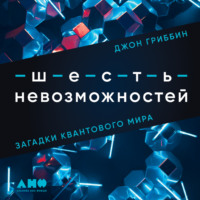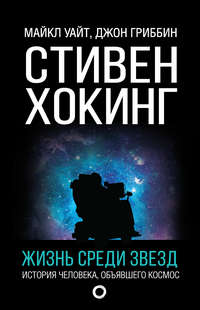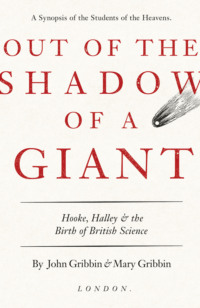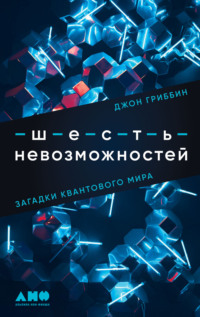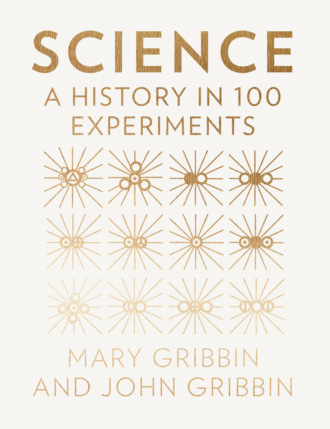
Полная версия
Science: A History in 100 Experiments
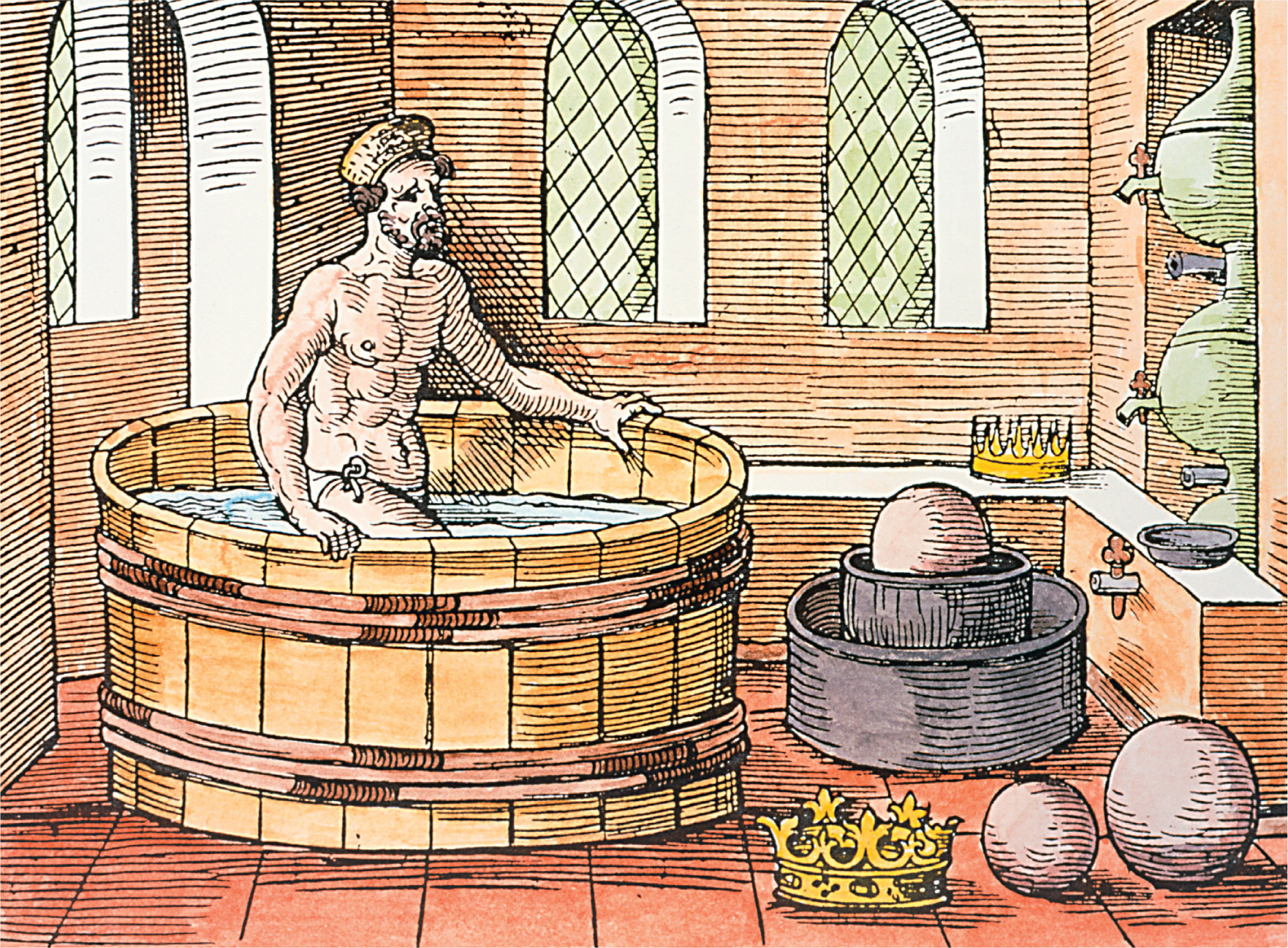
© Science Photo Library
An imaginative portrayal of the Greek mathematician and physicist Archimedes (287–212 BC) in his bath. Archimedes showed that an object immersed in a fluid is supported with a force equal to the displaced fluid’s weight (Archimedes’ principle).
What Archimedes had realized was that the volume of water displaced from the bath was equal to the volume of his body immersed in the water. As silver is less dense than gold, if the crown were made of a mixture of silver and gold it would have to be bigger than a crown made of pure gold in order to have the same weight. And he could measure the volume of the crown, without damaging it, by immersing it in water and seeing how much water was displaced.
Nobody knows exactly how Archimedes carried out the experiment. But the most likely method is based on an observation he described in his book, On Floating Bodies. There, Archimedes explained that the upward force (buoyancy) exerted on an object placed in water (or any other fluid) is equal to the weight of fluid that is displaced. This is now known as Archimedes’ Principle. And, of course, the weight of water displaced will be proportional to the volume of water displaced.
The obvious way to use this to test the purity of the crown, as Archimedes must have realized, would be to balance the crown against exactly the same weight of pure gold on a beam balance above a tank of water. Then, the balance is lowered until the crown and the pure gold sample are immersed in the water, while the balance arm stays above it. If both objects are made of pure gold, they will each displace the same volume (and therefore the same weight) of water, experience the same buoyancy force, and stay in balance. But if the crown is less dense than gold it will have a bigger volume, displace more water, and be more buoyant than the pure gold, so the balance will tip down on the side of the gold. The beauty of this experiment is that you don’t actually have to measure the volume of the crown, or the volume of water that it displaces; you just watch to see if the balance tilts.
That, it seems, is exactly what happened. Archimedes did the experiment (or something very similar) and found that the jeweller had indeed cheated the king. About five centuries after Vitruvius, the story was re-told in a Latin poem ‘Carmen de ponderibus et mensuris’ which described the use of such a hydrostatic balance, and in the twelfth century a manuscript called ‘Mappae clavicula’ gave detailed instructions on how to make weighings in this way to calculate the proportion of silver in the adulterated crown.
Archimedes’ Principle also explains why a ship made of steel can float. A solid lump of steel displaces a relatively small amount of water, much less than its own weight, and sinks. But if the same amount of steel is spread out in the shape of a boat, or even a simple bowl (like a coracle), a larger volume of water is displaced, weighing more than the weight of the steel, resulting in a large enough upwards force to make the boat float.
The first scientific attempt to measure the size of the Earth was made by a Greek polymath, Eratosthenes of Cyrene (276–194 BC), who was in charge of the Library of Alexandria in the third century BC. He was a contemporary and friend of Archimedes. His experiment involved some observations of his own, made in Alexandria, but combined with evidence from a far away place, the city then known as Syene (now Aswan), which he had never visited.
Eratosthenes learned that each year on the day of the summer solstice, when the Sun is at its highest in the sky, it was exactly overhead at Syene, south of Alexandria. Travellers told how the reflection of the Sun could be seen at the bottom of a deep well in Syene on that day. Even at the summer solstice, the Sun is not directly overhead at Alexandria, because, as Eratosthenes appreciated, the Earth is round. So he made careful measurements of the difference between the angle made by the Sun and the vertical at the time of the solstice, working out that this corresponded to one-fiftieth of a circle, or 7º 12ʹ of arc. Simple geometry told him that this meant that the distance from Alexandria to Syene was one-fiftieth of the circumference of the Earth, assuming (which is not quite true) that Syene lies due south of Alexandria.
The distance from Syene to Alexandria was well known even in Eratosthenes’ day (it is about 800 kilometres in modern units). Egyptian records gave the distance as 5,000 stades, and Eratosthenes checked this by asking camel train drivers how long it took them to make the journey (some sources say he hired a man to pace out the distance; but this may be apocryphal). This gave him a figure of 694 stades per degree, which he rounded off to 700. Multiplying by 360 gave him the circumference of the Earth – 252,000 stades (he could have just multiplied 5,000 by 50 to get the ‘answer’ 250,000, but apparently he did it the hard way).
So what is this in modern units? Unfortunately for us, the Greeks and Egyptians used slightly different stades, but the likelihood is that Eratosthenes, being Greek, used the Greek measurement, where one stade corresponds to 185 metres, which gives a circumference of 46,620 kilometres, only 16.3 per cent too big. In the unlikely event that he used the Egyptian measurement, with one stade corresponding to 157.5 metres, he would have come up with a figure of 39,690 kilometres, just a bit too small (less than 2 per cent smaller than the actual distance, 40,008 kilometres). Either way, it is impressive.
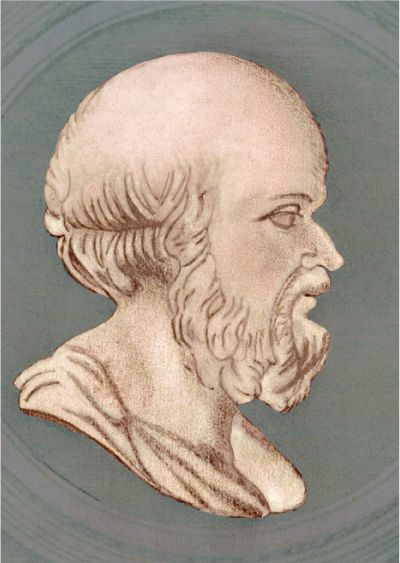
© Sheila Terry/Science Photo Library
Eratosthenes (c. 276–194 BC).
That was by no means the only impressive achievement of Eratosthenes. He used the information he found in the books in the Library of Alexandria to produce a three-volume book of his own in which he mapped and described the entire known world. He used grids of overlapping lines, like modern lines of latitude and lines of longitude, to locate places, and invented many of the terms still used by geographers today. More than four hundred cities were named and located in the book. Unfortunately the book itself, called Geographika, was lost, but parts of it have been reconstructed from references to it in other works. Book Two of Geographika included Eratosthenes’ estimate of the size of the Earth. According to Ptolemy, Eratosthenes measured the tilt of the Earth’s axis, which is related to the measurement of the circumference, very accurately, getting a value of 11/83 of 180º, which is 23º 51ʹ 15ʺ. He also worked out a calendar that included leap years, and he tried to establish a chronology of literary and political events going back to the siege of Troy.

© Collection Abecasis/Science Photo Library
The World by Eratosthenes. 1886 replica of a map of the known world according to the Ancient Greek geographer, mathematician and astronomer Eratosthenes.
Eratosthenes was very much an all-rounder, so much so that he had the nickname ‘Beta’, because he was second best at everything, according to his contemporaries. The Greek geographer Strabo, who lived from about 64 BC to AD 24, described Eratosthenes as the best mathematician among the geographers, and the best geographer among the mathematicians. In mathematics, he is known for a technique called ‘the sieve of Eratosthenes’, used to find prime numbers. This simple method, which he invented, involves making a list (or grid) of all the numbers up to the biggest one you are interested in (for example, 1 to 1000). Then, you cross off from the list all the multiples of 2, the first prime number (4, 6, 8 and so on, but not 2 itself), and check that the next lowest number not crossed off is prime (if it isn’t, you have made a mistake!). If it is, cross off all the multiples of that number (but not the number itself), and so on. Once you get to the end of the list, the numbers that have not been crossed off form the list of primes.
After the decline of classical civilization and before the European Renaissance, scientific knowledge was preserved and improved in the Arabic world. Greek texts were translated into Arabic and later from Arabic into Latin, which is how they became known to Europeans. But the Arabs also carried out original scientific work. The greatest scientist of the Middle Ages, the ‘Arabic Newton’, was Abu Ali al-Hassan ibn al-Haytham, known for short as Alhazen, who lived from about 965 to 1040 and carried out experiments in optics on either side of the year 1000. His influential book was published in Europe in Latin as Opticae Thesaurus (The Treasury of Optics) in 1572, five centuries after his death. It was a major influence on the ‘natural philosophers’ who started the scientific revolution in Europe.
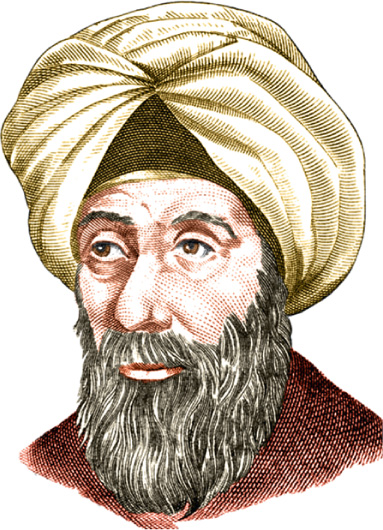
© Science Source/Science Photo Library
Abu Ali al-Hassan ibn al-Haytham (known as Alhacen, or Alhazen) (965–1040).
Alhazen’s key insight was that sight is not the result of some influence reaching out from the eyes and sensing the world outside, but is caused by light entering the eye from outside. In his own words, ‘from each point of every coloured body, illuminated by any light, issue light and colour along every straight line that can be drawn from that point’. This was not an entirely original idea. Philosophers had discussed whether vision was caused by an outward influence (emission) or an inward influence (intromission) since the time of Euclid and Aristotle. But Alhazen put together a complete, coherent package of ideas which he then proved correct by experiments based on the idea of a ‘camera obscura’ (literally, a ‘dark room’; the Latin term is the source of our modern word camera). In a dark room with a heavily curtained window, if a tiny hole is made in the curtain on a sunny day an image of the outside world will be projected, upside down, on the wall opposite the window. The phenomenon had been known to the ancients, but Alhazen was the first person to describe it clearly and explain what is going on.
Alhazen realized that light travels in straight lines. Light from the top of a tree in the garden outside the window of the camera obscura will go through the hole in the curtain to the bottom of the wall opposite. Light from the base of the tree will go through the hole and up to the top of the wall. Straight lines from other points on the tree, and from other objects outside the window, go through the hole in straight lines to corresponding places on the wall to make the image.
He might have stopped there. Before Alhazen, those philosophers who thought about such things at all, such as Euclid and Aristotle, usually stopped at this stage, without actually doing experiments to test their ideas. They tried to persuade people that they were right by logic and reason, without getting their hands dirty (Archimedes, of course, was a notable, but rare, exception). What made Alhazen a real scientist was that he went a stage further. It was one thing to show how a camera obscura worked, but something else to prove that the eye works in the same way. A thousand years ago, many people would have assumed that living things were not subject to the same rules as inanimate objects. To test whether this was so, he took an eyeball from a bull, and carefully scraped away at the back of it, thinning it down until he could see on the back of the eyeball an image of what was in front of the eye, almost exactly like a tiny camera obscura. He had proved that light travels in straight lines, shown how a camera obscura works, and established that no mysterious life force is needed to explain vision, just the same physical laws that apply to non-living things. And he had done so using what became known (eventually) as the scientific method – thinking up ideas (hypotheses) about how the world works based on observation, then testing those ideas by experiment. Today, an idea that passes the experimental test is upgraded to the status of a theory, while those that fail the experimental test are discarded. As the twentieth-century physicist Richard Feynman pithily put it, ‘if it disagrees with experiment then it is wrong’. Because he understood this and put it in to practice, Alhazen was arguably the first modern scientist.
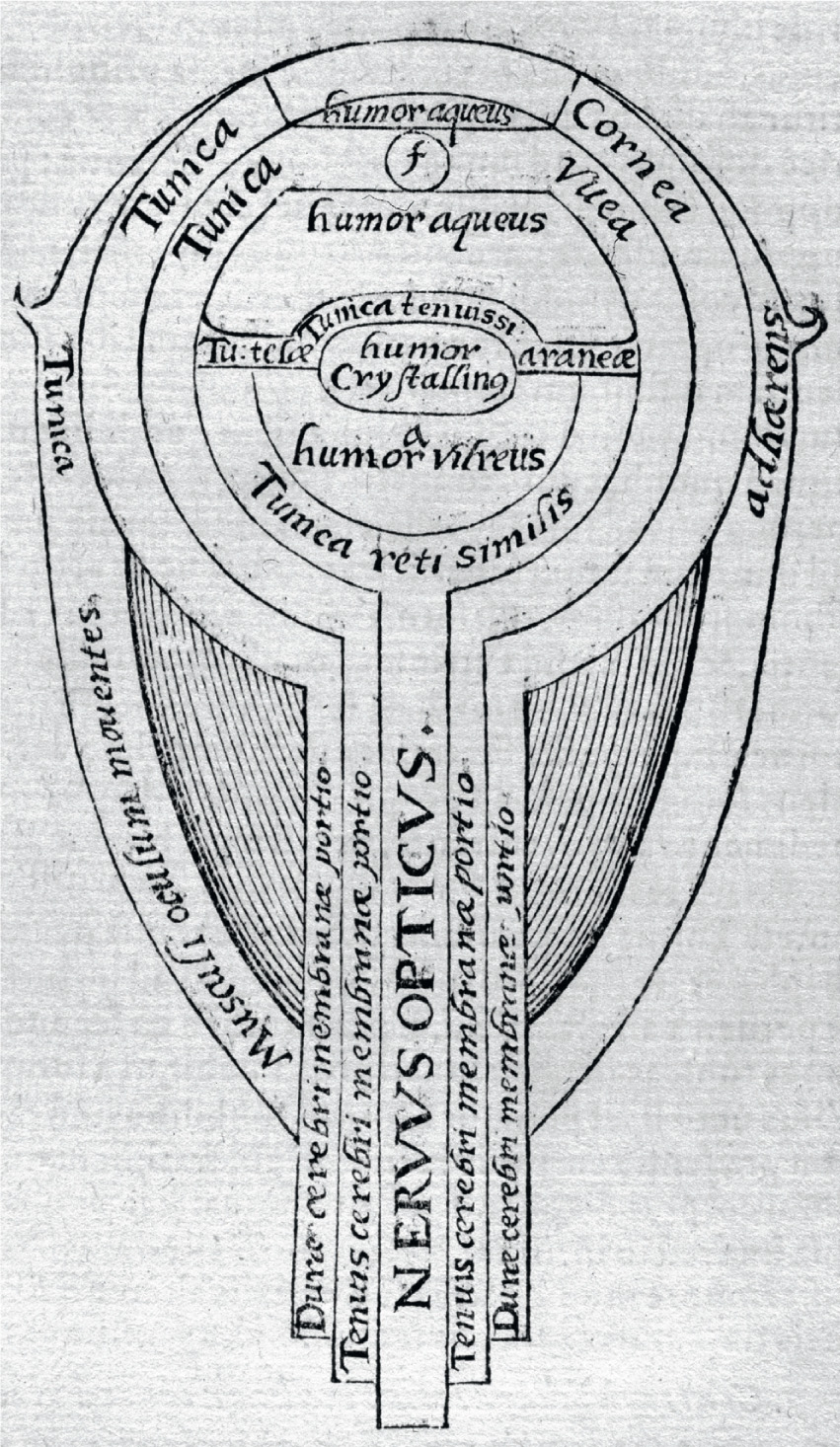
© Science Museum/Science & Society Picture Library
Alhazen’s representation of the eye as a ‘camera’.
Alhazen did much more than this. He wrote on a variety of scientific and mathematical topics, and his optical work alone filled seven books. He realized that light does not travel at infinite speed, although it is very fast, and he explained the illusion that a straight stick looks bent when one end is placed in water because light travels at different speeds in water and in air. He studied lenses and curved mirrors, working out how the curvature makes them focus light. But his place in history has been secured by how he worked as much as by what he studied. It was the true beginning of experimental science.
The scientific Renaissance began in the middle part of the sixteenth century, and a significant marker is the year 1543, when Copernicus published his famous book De Revolutionibus Orbium Coelestium (On the Revolution of Celestial Bodies), displacing the Earth from its supposed special position in the Universe, and Andreas Vesalius published De Humani Corporis Fabrica (On the Structure of the Human Body), going some way towards displacing humankind from a supposed special position in the animal world. Copernicus’s story is well known, and he did not, strictly speaking, carry out experiments. But Vesalius is less well known, and deserves more attention than he often gets. He did carry out experiments – on human bodies.
Vesalius was born in Brussels in 1514, but carried out his important work at the University of Padua (where he was Professor of Anatomy) in the late 1530s and early 1540s. Before that time, when human dissections were carried out (which was not very often), the actual cutting was done by barber-surgeons, who were little more (arguably less) than butchers. The professor would stand at a safe distance (literally without getting dirty) and lecture to students about what was being uncovered, using imagination as well as actual evidence. Vesalius changed all that. He carried out the dissections himself, showing as well as telling the students what was going on, and developing a much better understanding of the human body. He was helped by the civil authorities in Padua – in particular, the judge Marcantonio Contarini, who not only supplied him with the bodies of executed criminals but would time the executions to fit in with Vesalius’s need for a fresh cadaver for a lecture. This was in marked contrast to his time as a student in Paris, where Vesalius (like his fellow medical students) had been reduced to grave-robbing to get specimens for his studies.
Before Vesalius, the accepted understanding of human anatomy had been handed down since ancient times, and was based on the work of the Romano-Greek physician Claudius Galenus (known as Galen). In the Middle Ages in Europe, it was thought that the ancients had been much wiser than contemporary people, and that they had superior knowledge which could not be emulated, much less exceeded. But this was wrong. Galen was an enthusiastic dissector, but most of his work was carried out on dogs, pigs, and monkeys, because human dissection was infra dig in the second century AD. So his description of the human body was often wildly inaccurate.
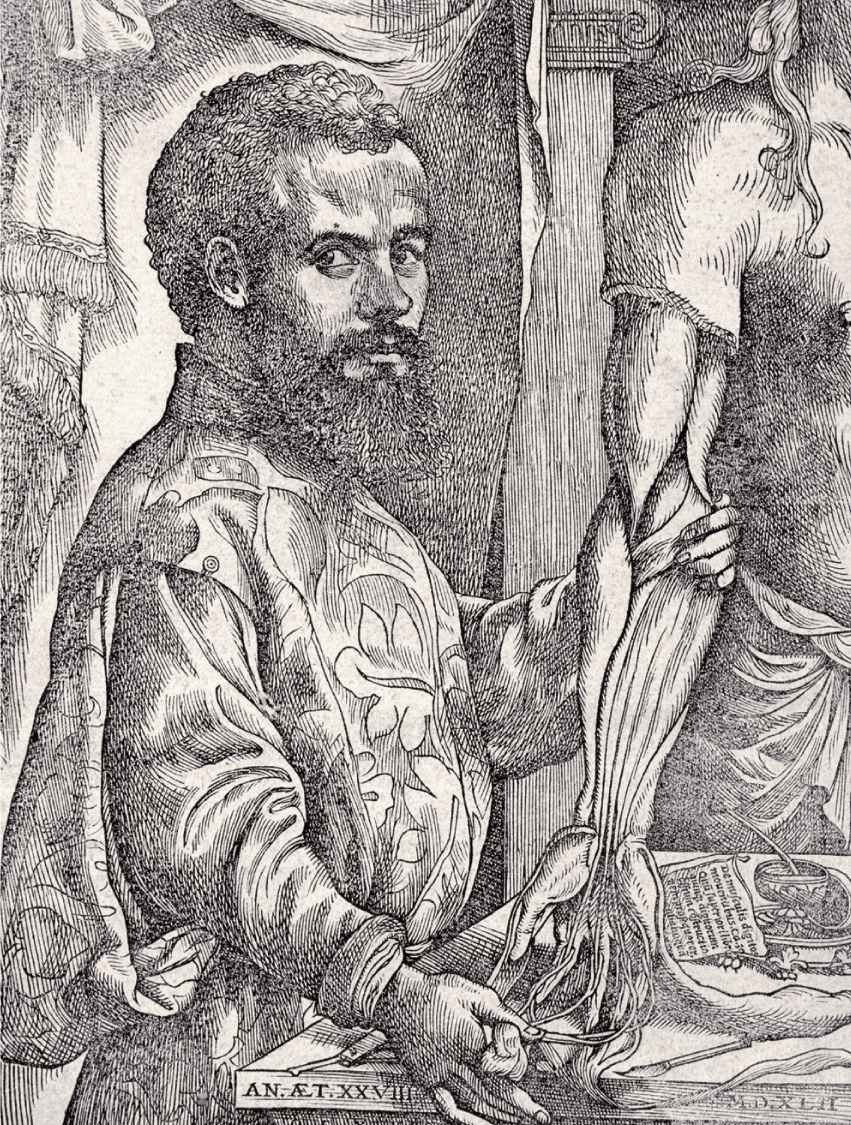
© British Library/Science Photo Library
Andreas Vesalius (1514–1564).
The big contribution Vesalius made was not just to improve the understanding of human anatomy, but to stress the importance of using the evidence in front of you and your own experiments to find things out, instead of relying on the supposedly superior wisdom of the ancients. This, of course, echoed what was happening in astronomy at the same time. Vesalius, who once wrote, ‘I am not accustomed to saying anything with certainty after only one or two observations’, used to carry out ‘parallel dissections’ in which an animal body and a human body are dissected side by side, to highlight the anatomical differences between them, explicitly correcting Galen’s errors.
Vesalius also used highly skilled artists to prepare large diagrams to use in his lectures (a sixteenth-century equivalent of PowerPoint), and six of these were published as Tabulae Anatomica Sex (Six Anatomical Pictures) in 1538. He drew three of the illustrations himself, but the other three were made by John Stephen of Kalkar (Jan Stephen van Calcar), a pupil of Titian. Stephen is also thought to have been the main illustrator for Vesalius’s masterwork, the Fabrica, which appeared in seven volumes in 1643. But Vesalius’ pioneering activity did not stop there. The Fabrica was a book for experts – other professors and doctors. In order to make his work accessible to students, and even to educated laymen, he produced alongside it, and published in the same year, a summary officially titled De Humani Corporis Fabrica Librorum Epitome (Abridgement of the Structure of the Human Body) but known as the Epitome. And all before he was 30. He then gave up teaching, and spent the rest of his career practising medicine as a Court Physician, first to the Holy Roman Emperor Charles V and then to Charles’s son, Philip II of Spain (who later sent the Spanish Armada against England).
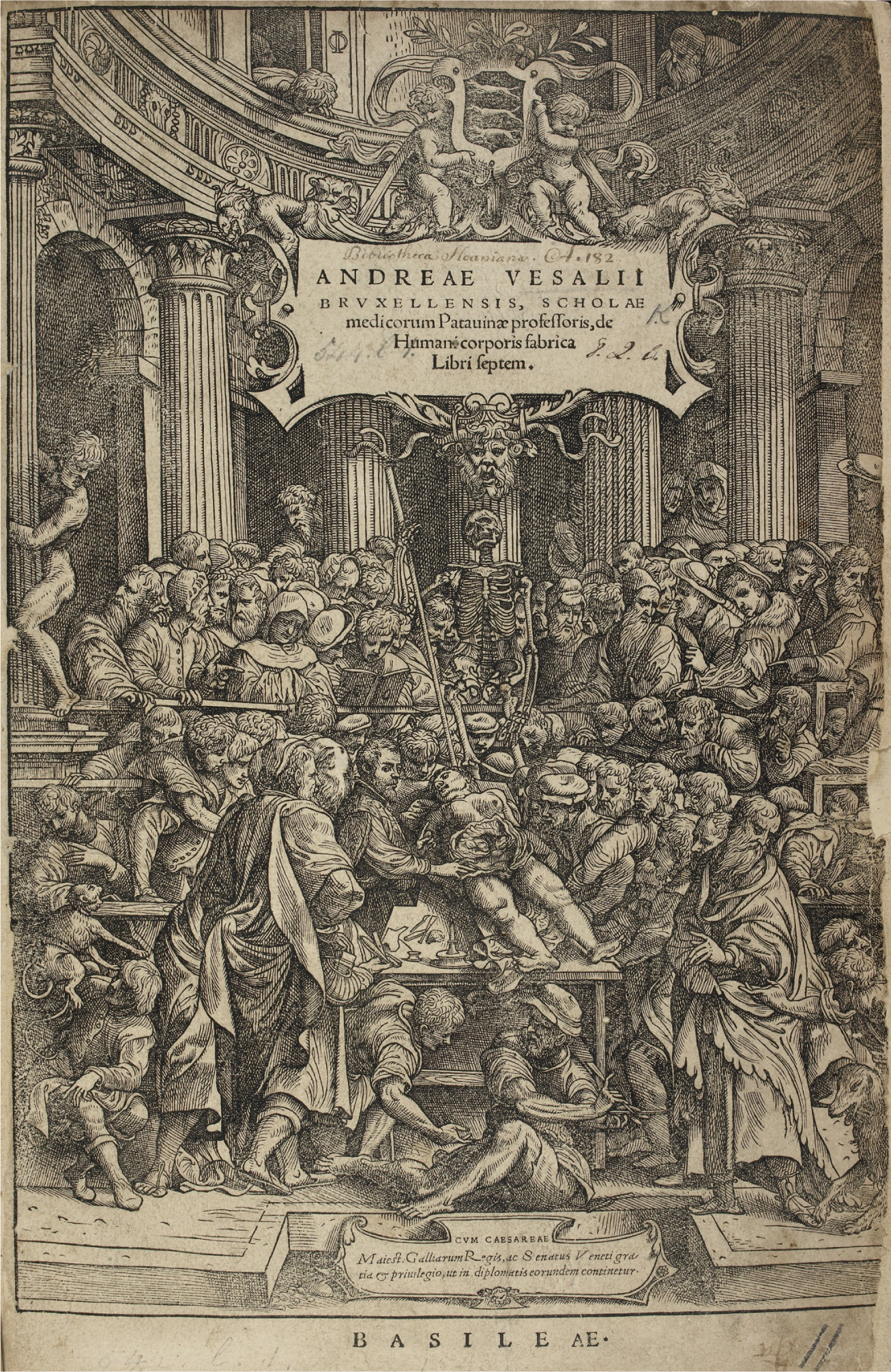
© British Library/Science Photo Library
Sixteenth-century frontispiece from De Humani Corporis Fabrica, showing a public dissection.
This change of career may have been caused by the opposition to his ideas from some of his peers, even in Padua. Jacobus Sylvius, a physician of the old school based in Paris, said that Vesalius was mad and that any advance of anatomical knowledge beyond Galen was impossible. It was more likely, he said, not that Galen was wrong, but that the human body had changed since his time. In 1543, science still had a long way to go.
If you were looking for a key date to mark the transition from a superstitious and mystical view of the world to the scientific study of our surroundings, you could do worse than pick 1600, the year in which the first book based solely on scientific experimentation was published. The book was called De Magnete Magneticisque Corporibus, et de Magno Magnete Tellure (Concerning Magnetism, Magnetic Bodies, and the Great Magnet Earth), usually shortened to De Magnete, and it was the work of an Elizabethan physician/scientist who had spent years studying magnetic phenomena.
William Gilbert had been born in 1544, studied at Cambridge and eventually became a Court Physician, first to Elizabeth I then to James I of England and VI of Scotland. As a wealthy gentleman, he was able to indulge his passion for science as an amateur, but reportedly spent £5,000 of his own money on this ‘hobby’. He died, probably of bubonic plague, in 1603.
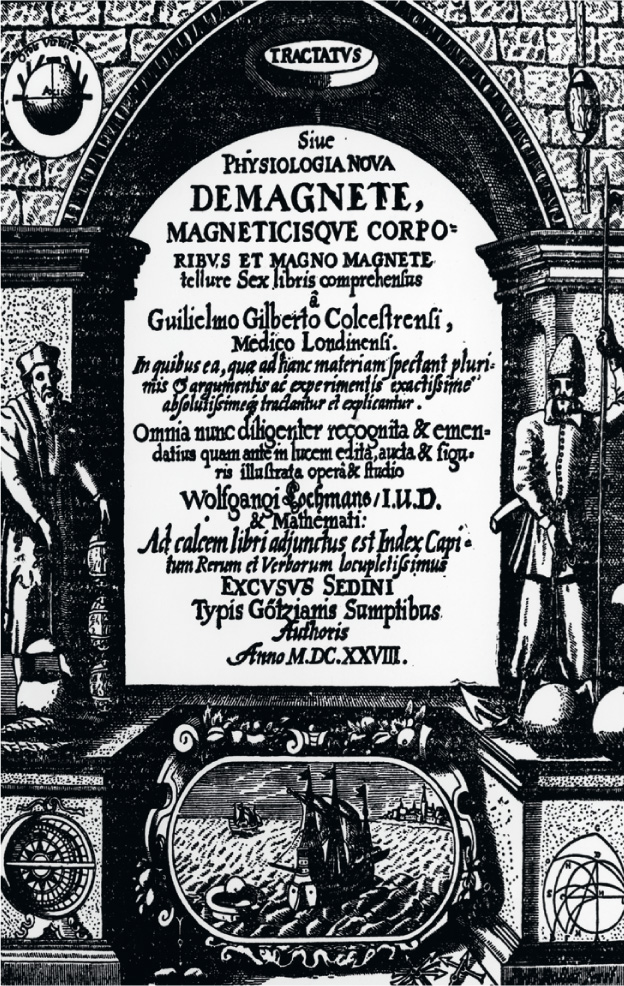
© Science Photo Library
Title page of the second edition of William Gilbert’s De Magnete, published in 1628.
Some of the most important experiments carried out by Gilbert concerned the magnetism of the Earth. At the time, seafarers were opening up the exploration of the world, and the magnetic compass was an invaluable tool, although nobody understood how it worked. Gilbert discussed the behaviour of compass needles with ships’ captains and navigators, and disproved by experiment many superstitions, such as the idea that a magnetic compass could be desensitized by rubbing it with garlic, or even by garlic breath. He then worked with naturally occurring magnetic rocks called lodestones, shaped into magnetized spheres that he called terrellae (meaning little Earths). He studied the magnetism of these spheres with magnetized needles which could be moved around the spheres. Gilbert showed that these behaved like compass needles at different places on Earth, and concluded that the Earth had an iron core which behaved like a bar magnet, with a North Pole and a South Pole. Before he carried out these experiments, philosophers had argued that compass needles pointed north because they were attracted to the Pole Star, or, alternatively, that there was a large magnetic island at the north geographical pole.
All of this represented a dramatic scientific leap forward, which is so obvious to modern eyes that it is hard to appreciate its revolutionary nature at the time. Gilbert regarded his terrellae as models of the real Earth, and accepted that the results he obtained – for example, in the way the angle of dip of a magnetized needle depends on its place on the magnetized sphere – could be scaled up to tell us what the Earth itself is like. He was extrapolating from models to the world at large, a key feature of science in subsequent centuries.
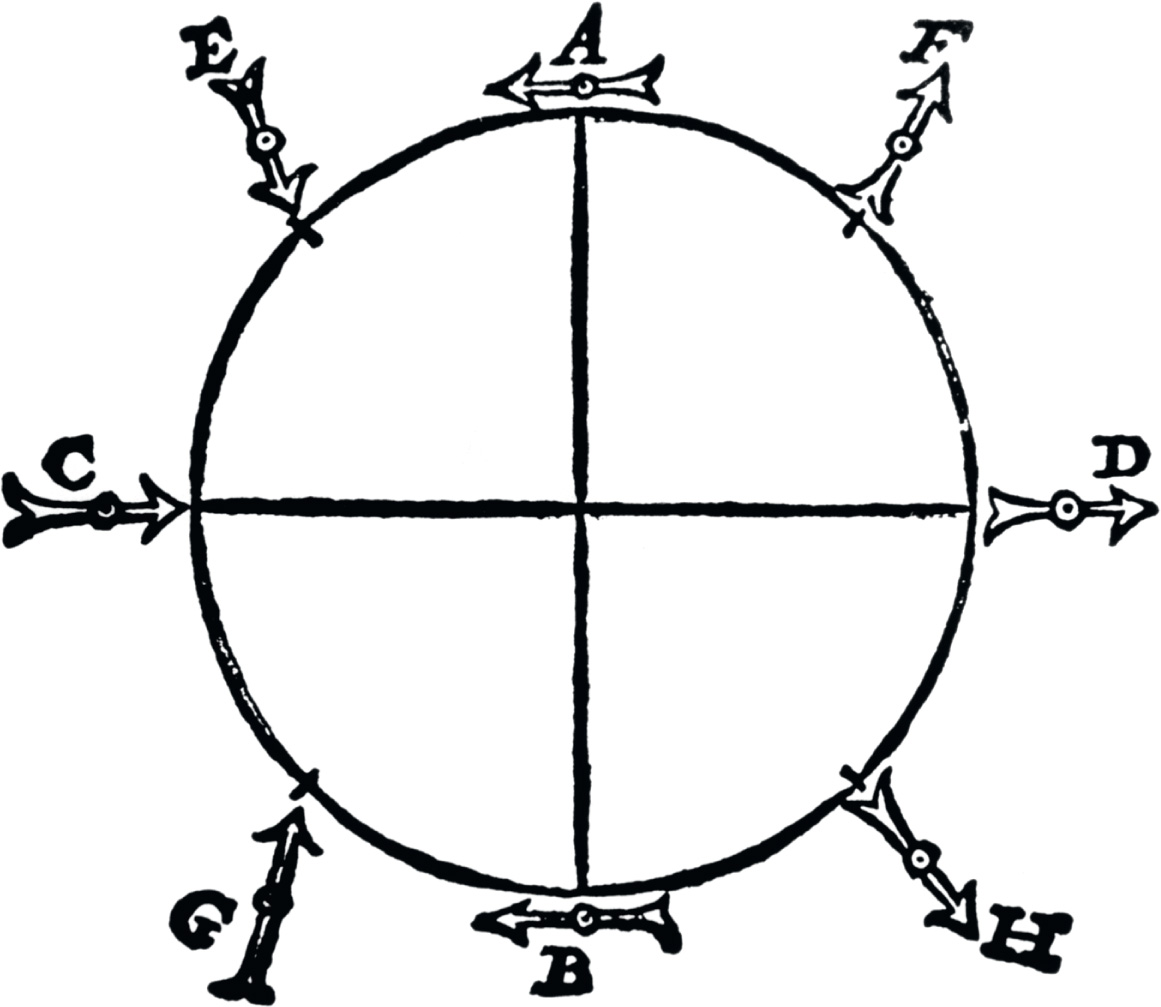
© Science Photo Library
William Gilbert’s illustration of the angle of dip of a magnetic field surrounding the Earth; the line AB is the equator, C is the North Pole, and D is the South Pole.
As a result of these experiments, Gilbert was the first person to appreciate that, because magnetic opposites attract, the end of a magnet that points northwards (towards the north magnetic pole of the Earth) ought to be called the south pole. (In modern language, scientists sometimes refer to the ‘north-seeking’ pole and the ‘south-seeking’ pole of a magnet to avoid this confusion.) Gilbert said: ‘All who hitherto have written about the poles of the loadstone, all instrument-makers, and navigators, are egregiously mistaken in taking for the north pole of the loadstone the part of the stone that inclines to the north, and for the south pole the part that looks to the south: this we will hereafter prove to be an error. So ill-cultivated is the whole philosophy of the magnet still, even as regards its elementary principles.’
Indeed, it was Gilbert who introduced terms such as ‘magnetic pole’ and ‘electric force’ into the language. He was the first person to realize that magnetism and electricity (a word he invented) are separate phenomena, and his work on magnetism was not improved upon for two centuries, until the work of Michael Faraday.
Gilbert’s book caused a sensation in its day, and was highly influential. Galileo was one of its readers, and commented favourably on it in a letter to a friend. Indeed, Galileo described Gilbert as the founder of the scientific method. In Gilbert’s own words: ‘In the discovery of secret things, and in the investigation of hidden causes, stronger reasons are obtained from sure experiments and demonstrated arguments than from probable conjectures and the opinions of philosophical speculators.’ That is science in a nutshell, and in his book Gilbert was careful to spell out every detail of his experiments, so that other people could carry them out and see the results for themselves. But he cautions whoever does this ‘to handle the bodies carefully, skilfully and deftly, not heedlessly and bunglingly; when an experiment fails, let him not in his ignorance condemn our discoveries, for there is naught in these Books that has not been investigated and again and again done and repeated under our eyes’.




